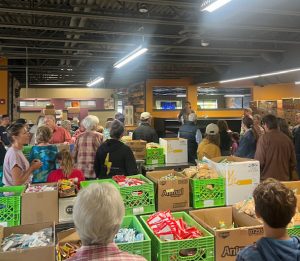Nourishing the Community: Organizing a Food Drive


When it comes to positively impacting your community, a few endeavours are as rewarding and meaningful as organizing a food drive. These charitable initiatives can bring people together, address food insecurity, and provide vital support to those in need. This article will explore the art of organizing a food drive, from inception to execution, highlighting key strategies and considerations.
Setting the Foundation: Purpose and Goals
Define Your Purpose: Before diving into the logistics, it’s essential to determine the purpose of your food drive. Are you focusing on providing holiday meals, supporting a local food bank, or aiding a specific demographic, such as children or seniors? A clear purpose will guide your efforts.
Set Realistic Goals: Establish specific, measurable goals for your food drive. Consider factors like the number of items to collect, the target amount of funds to raise, or the duration of the drive. Having clear objectives will help motivate participants and measure your success.
Identify Beneficiaries: Determine who will benefit from your food drive. This could be a local food bank, a homeless shelter, or families within your community. Understanding the needs of your chosen beneficiaries will inform your collection strategy.
Spreading the Word: Promotion and Outreach
Create a Buzz: Generate excitement and awareness for your food drive through effective promotion. Utilize social media, local newspapers, flyers, and community bulletin boards to spread the word. Highlight the purpose and goals of the drive to attract potential donors.
Engage the Community: Involve the community in the planning process. Partner with local businesses, schools, churches, and organizations to expand your reach. Collaboration enhances the impact of your food drive and fosters a sense of unity.
Harness Online Resources: Leverage online platforms for visibility and convenience. Create a dedicated website or social media pages to provide updates, share stories, and facilitate online donations. Make it easy for people to get involved digitally.
Collection Strategies: Gathering Donations
Organize Collection Points: Set up easily accessible collection points at strategic locations throughout your community. These can be in supermarkets, schools, churches, or local businesses. Mark collection bins and provide information about the drive.
Donation Guidelines: Communicate what items are needed and accepted. Focus on non-perishable, nutritious items like canned goods, pasta, rice, and baby food. Provide guidelines to ensure donations are safe and suitable for distribution.
Fundraising Options: Besides food donations, consider incorporating fundraising elements into your drive. This can include virtual fundraisers, donation drives, or partnerships with local restaurants and businesses that contribute a portion of their profits.
Encourage Healthy Competition: Introduce friendly competitions or challenges within your community. For example, schools can compete to collect the most food items, or businesses can challenge each other to raise the most funds. Recognition and incentives can boost participation.
Logistics and Organization
Volunteer Coordination: Recruit and organize volunteers to assist with collection, sorting, and distribution. Assign roles and responsibilities to ensure a smooth operation. Volunteers are the backbone of any successful food drive.
Collection Schedule: Establish a clear timeline for the food drive. Specify start and end dates and the dates for collection, sorting, and delivery. Consistency and organization are crucial to managing logistics effectively.
Safe Handling: Train volunteers on safe food handling practices to ensure the quality and safety of donated items. Pay attention to expiration dates and inspect items for damage or tampering.
Distribution Planning: Plan the distribution of collected items to beneficiaries. Coordinate with local organizations or food banks to ensure that donations reach those in need promptly.
Expressing Gratitude
Acknowledge Donors: Show appreciation to all donors and volunteers. Publicly recognize their contributions through social media, thank-you notes, or local news outlets. Gratitude fosters a sense of accomplishment and encourages continued support.
Reporting and Transparency: A transparent account of the food drive’s results. Share statistics on the number of items collected, funds raised, and the impact on the community. Transparency builds trust and encourages future involvement.
Sustaining the Momentum
Post-Drive Reflection: After the food drive concludes, gather feedback from volunteers and participants. Assess what worked well and identify areas for improvement. Use this information to refine your strategies for future drives.
Year-Round Engagement: Maintain a year-round commitment to addressing food insecurity. Explore ongoing initiatives, partnerships, or volunteer opportunities with local organizations to continue making a difference.
Set Future Goals: Challenge yourself to set higher goals for your next food drive. As your community becomes more engaged and supportive, you can expand your efforts and make an even more significant impact.
Organizing a food drive is a powerful way to contribute positively to your community and address the issue of food insecurity. By carefully planning and executing your drive, engaging the community, and maintaining transparency and gratitude, you can create a sustainable and impactful initiative that benefits those in need. Remember that the essence of a food drive lies not only in the items collected but also in the sense of unity and compassion it fosters within your community.
